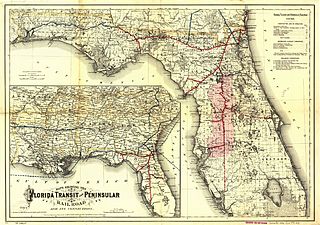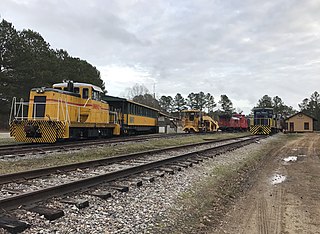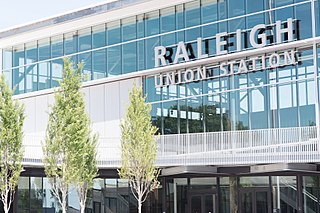Related Research Articles
The Florida Northern Railroad Company, Inc. is one of several short line railroads run by Regional Rail, LLC. It has connections to CSX at Ocala, Florida, running north to Lowell, Florida, and south to Candler, Florida. It was formerly run by CSX as their Ocala Subdivision.

The Florida Central and Peninsular Railroad was the final name of a system of railroads throughout Florida, becoming part of the Seaboard Air Line Railway in 1900. The system, including some of the first railroads in Florida, stretched from Jacksonville west through Tallahassee and south to Tampa. Much of the FC&P network is still in service under the ownership of CSX Transportation.
The Wilmington and Weldon Railroad (W&W) name began use in 1855, having been originally chartered as the Wilmington and Raleigh Railroad in 1834. When it opened in 1840, the line was the longest railroad in the world with 161.5 miles (259.9 km) of track. It was constructed in 4 ft 8 in gauge. At its terminus in Weldon, North Carolina, it connected with the Seaboard and Roanoke Railroad and the Petersburg Railroad. The railroad also gave rise to the city of Goldsboro, North Carolina, the midpoint of the W&W RR and the railroad intersection with the North Carolina Railroad.
The Georgia, Carolina and Northern Railway was a Southeastern railroad that began after Reconstruction and operated up until the start of the 20th century. It ran from Monroe, North Carolina to Atlanta, Georgia and later became part of the Seaboard Air Line Railroad.

The New Hope Valley Railway is a heritage railroad in Bonsal, North Carolina operated by the North Carolina Railway Museum, Inc., an all-volunteer, nonprofit, and tax exempt educational and historical organization.
The Piedmont & Northern Railway was a heavy electric interurban company operating over two disconnected divisions in North and South Carolina. Tracks spanned 128 miles (206 km) total between the two segments, with the northern division running 24 miles (39 km) from Charlotte, to Gastonia, North Carolina, including a three-mile (5 km) spur to Belmont. The southern division main line ran 89 miles (143 km) from Greenwood to Spartanburg, South Carolina, with a 12 mi (19 km) spur to Anderson. Initially the railroad was electrified at 1500 volts DC, however, much of the electrification was abandoned when dieselisation was completed in 1954.

Raleigh Union Station is an intermodal transit station in Raleigh, North Carolina, United States. Train service began the morning of July 10, 2018. Its main building serves as an Amtrak train station, while a future adjacent building will serve as the bus terminus for GoTriangle. The station is located at the Boylan Wye, a railroad junction used by CSX and Norfolk Southern, and adjacent to the Depot Historic District in downtown Raleigh.
The following is a brief history of the North American rail system, mainly through major changes to Class I railroads, the largest class by operating revenue.
The Cape Fear and Yadkin Valley Railway was a Southeastern railroad that operated in the Carolinas immediately after Reconstruction. It ran from Mount Airy, North Carolina southeast through Greensboro and Fayetteville to the Atlantic port of Wilmington, North Carolina. A significant branch also ran from Fayetteville south to Bennettsville, South Carolina.
The Thermal Belt Railway is a Class III shortline railroad that operates for freight service on an irregular schedule on a former CSX line from Bostic to Forest City and on a former Norfolk Southern line from Forest City to Alexander Mills, North Carolina. Total mileage is 8.5 miles (13.7 km). Connections are made with CSX at Bostic. Rail is 85 pounds.
The Florida Western and Northern Railroad was a subsidiary of the Seaboard Air Line Railroad that expanded their network in the 1920s by building a rail line from Coleman, Florida all the way to West Palm Beach via Auburndale and Sebring, a distance of 204 miles. The line would be extended to Miami by the Seaboard-All Florida Railway, another Seaboard Air Line subsidiary, shortly after with the full line from Coleman to Miami becoming the Seaboard Air Line's Miami Subdivision. The line is still in service today from Auburndale to West Palm Beach and is now operated by Seaboard successor CSX Transportation as their Auburndale Subdivision.
The Tampa Northern Railroad was a historic railroad line running from just east of downtown Tampa north to the city of Brooksville in Hernando County. The line continues to operate today and is under the ownership of the CSX Corporation, who operates it as their Brooksville Subdivision north of Sulphur Springs and part of their Clearwater Subdivision south of there.
The Norlina Subdivision is a railroad line owned by CSX Transportation in the U.S. State of North Carolina. The line currently runs from Norlina, North Carolina, to Raleigh, North Carolina, for a total of 51.2 miles. At its north end the line comes to an end and at its south end the line continues north from the Aberdeen Subdivision. While the current line dates back to 1840, it has been known as the Norlina Subdivision since the 1970s. Under CSX's predecessor, the Seaboard Coast Line Railroad, the Norlina Subdivision continued north to Collier Yard near Petersburg, Virginia.
The W&W Subdivision is a railroad line owned by CSX Transportation in the U.S. state of North Carolina. The line runs from just south of Wilson, North Carolina, to Wallace, North Carolina, for a total of 69.1 miles. At its north end the line connects to CSX's A Line. The line's name stands for the Wilmington and Weldon Railroad, the company that originally built the line.
The Richmond, Petersburg and Carolina Railroad was a railroad built in the early 1900s. As its name suggests, it ran from Richmond, Virginia south through Petersburg into northern North Carolina. It was a key part of the network of the Seaboard Air Line Railroad.

The Atlantic Coast Line Railroad’s Main Line was the backbone of the Atlantic Coast Line Railroad's network in the southeastern United States. The main line ran from Richmond, Virginia to Port Tampa just southwest of Tampa, Florida, a distance of nearly 900 miles. Along its route it passed through Petersburg, Rocky Mount, Florence, Charleston, Savannah, Jacksonville, and Orlando. With the exception of a short 61-mile segment in Greater Orlando, the entire line is still owned by the Atlantic Coast Line's successor, CSX Transportation, and is still in service as their A Line.
The Seaboard Air Line Railroad’s Main Line was the backbone of the Seaboard Air Line Railroad's network in the southeastern United States. The main line ran from Richmond, Virginia to Tampa, Florida, a distance of over 800 miles. Along its route it passed through Petersburg, Raleigh, Columbia, Savannah, Jacksonville, and Ocala, Florida. While some segments of the line have been abandoned as of 2022, most of the line is still in service and is owned by the Seaboard Air Line's successor, CSX Transportation as their S Line.
References
- ↑ Alan Coleman (2008). Railroads of North Carolina. Arcadia Publishing. pp. 86–. ISBN 978-0-7385-5336-8.
- ↑ Red Springs & Northern Railroad Foundation (WRAL TV)